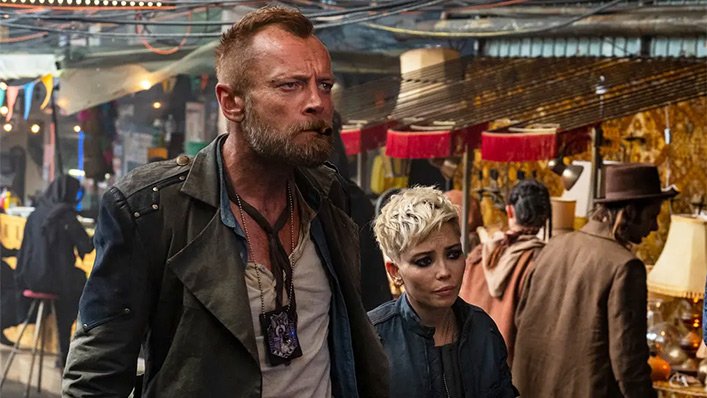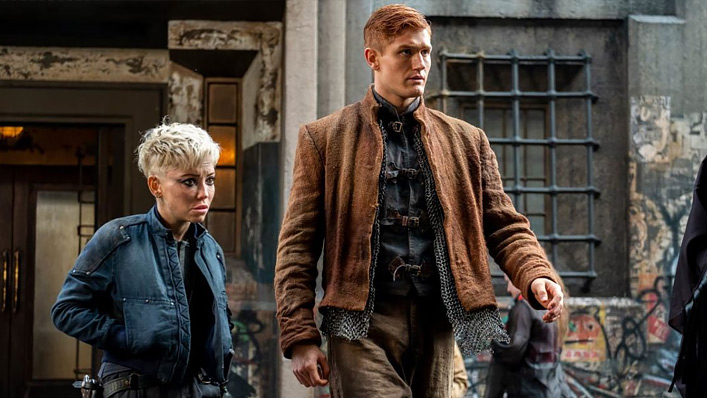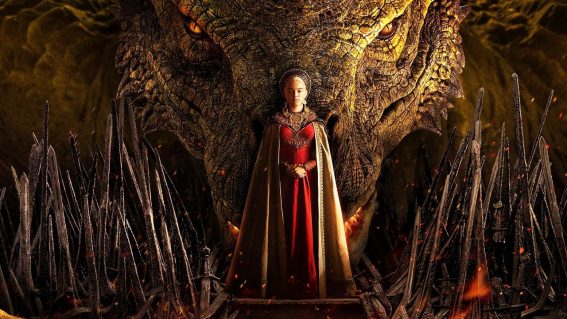The Watch’s gloriously weird world more than makes up for a wonky plotline

Fantasy police procedural series The Watch (now streaming on Stan) presents a strikingly weird central location that critic Luke Buckmaster can’t wait to return to.
I love the scrappy, atavistic aesthetic of Ankh-Morpork in The Watch: the central setting for BBC’s new Discworld-inspired fantasy series, which looks like a city was cobbled together from the detritus of various actual and fictitious places—from contemporary London to Westeros or Bartertown—and given a steampunk twist. It’s as though the set designers intended to visually represent tension between imaginative possibilities and real-world limitations, or as if they were caught between the desire to conjure something fantastical or something lifelike—but either couldn’t decide or chose both.
See also
* All new movies in cinemas
* All new streaming movies & series
The show (created by Simon Allen and directed by Emma Sullivan, Craig Viveiros and Brian Kelly) is introduced as being set “somewhere in a distant secondhand dimension,” the look and tone of this surreal city—located in a kind of half reality—entirely justifying that description. Secondhand is the operative word, but not in a negative sense; The Watch looks used and discounted in a genuine lived-in way. And in this weird place there is a funny energy in the air that encourages and normalises peculiar behaviour.
Following police procedure in the titular law enforcing/breaking/bending outfit isn’t easy, as idealistic new cop in town Constable Carrot (Adam Hugill) discovers. Society has been divided into various guilds, all very powerful, like unions on steroids, which offer state-sanctioned protection for members. The thieves guild for instance allows people to legally steal—as Carrot discovers after arresting a man for a robber in broad daylight—and the assassin’s guild permits murder. That groups of powerful vested interests are given carte blanche by the government to act above the law is one of show’s least fantastical aspects is an indictment on our real-world societies.

The peculiarities of Ankh-Morpork even seem to encourage odd behaviour from outside the narrative universe. Take Richard Dormer’s performance as Captain Sam Vimes (Richard Dormer), the head of The Watch and more or less the protagonist of the series, though he doesn’t so much lead it as struggle to make sense of it; both he and his character seem bamboozled by everything.
The series begins with Vimes in conversation with Death, asking the hooded presence with glowing blue eyes how he got here. Cue flashback: to the rain-drenched back alleys of the city, during a seminal moment in Vimes’ early career, during which a superior pumps him up with talk about how in 20 years Vimes will “become a Captain, an inspiration, a symbol of good.” Fast forward: to Vimes giving the hard word to a cute rough-haired white dog that reacts by peeing on his leg.
Vimes’ behaviour throughout the first two episodes (which form the extent of this review) doesn’t play in the key of the rascal with a heart of gold; he seems, refreshingly and somewhat perversely, like a genuinely dodgy dude, amoral at best. And Richard Dorme bug-eyed performance is bizarre: sort of cartoony and over-the-top, but not in the expected way that would have him bellowing and bouncing off the walls and stomping around defiantly. He has a strange stoop in his step and his manicness and desperation seem like natural consequences of living in this world.
It suits Dorme when he is chomping on a cigar or rolling the wet stubby thing around his mouth, because it gives the actor something else to do other than scrunch and unscrunch his face and switch between half-crazed expressions. And it’s more pleasant than listening to him speak—because he talks like he’s got sock in his mouth, almost literally chewing over his words, like a parody of a pirate or a parody of Hunter S Thompson, or a parody of Johnny Depp in either role. You have to pause for a moment to contemplate whether he’s nailing it or derailing the show…and you’re never sure.
That initial afterlife flashback framing device is distracting and effectively splits the Vimes character in two—when it’s tough enough to get a handle on the one, or even the story more broadly. There’s already a lot going on without the pogoing between realities and time periods adding, which makes the show’s structure feel haphazard and discombobulating, with a wackiness that comes at you from all angles.
Adapting Terry Pratchett is like adapting Douglas Adams: beyond some visual inventions (such as camera-like devices that are actually powered by tiny imps drawing very quickly) you can expect none of the author’s brilliant zaniness to translate easily on screen—not even the dialogue. The Ankh-Morpork in The Watch looks nothing like I envisioned it after reading Pratchett’s books, but who cares? I love its shonkiness, its scrappiness, its punkishness.
I’m excited about returning to this world; in fact I wish this series were a videogame—so I could explore it on my own terms. One can easily imagine missions involving tracking down suspicious parties or magical orbs. But there’s no way a videogame adaptation would look like this: the expectation would be more along the lines of Zelda or The Witcher; i.e. a more conventional and palatable fantasy design. Meaning we’re stuck with this version of The Watch or nothing—which, structural imperfections and wonky plotting notwithstanding, is perfectly fine with me.
















